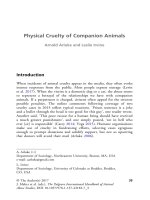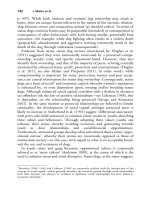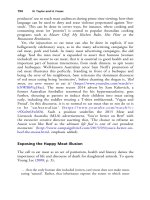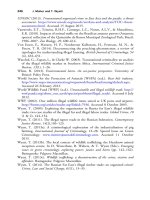The palgrave international handbook of a 277
Bạn đang xem bản rút gọn của tài liệu. Xem và tải ngay bản đầy đủ của tài liệu tại đây (37.79 KB, 1 trang )
274
K. Young
often focuses on the injuries to and fatalities of horses that occur before,
during and after competition. For many years, in the lead-up to July, local
newspaper editorials have been replete with impassioned letters of both
support for and condemnation of the Stampede, and particularly, the
chuckwagon racing. As the following examples show, just a cursory glance
through local and national newspapers reveals the newsworthiness of serious
accidents at the Stampede ‘chucks’: ‘Two horses die during race on first night
of Stampede’ (Globe and Mail 2006 July 10, p. A8); ‘Horse put down at
derby’ (Calgary Sun 2011 July 9, p. 6); ‘Second horse put down at Calgary
Stampede; Broken leg discovered after chuckwagon race’ (Stone and Ho
2011, p. A2); and ‘4 Calgary Stampede horses die in 2015 chuckwagon races’
(CBC News 2015a).
In addition to the public discourse often aired in the media, several animal
rights and animal welfare organizations such as People for the Ethical
Treatment of Animals (PETA), the Vancouver Humane Society (VHS),
and the Calgary Humane Society (CHS) have run provocative public awareness campaigns opposing the inclusion of animals in Stampede events. As
described by Gerber and Young (2013), emotive headlines and graphic
images broadcast in the news media related to injured or dying animals
sometimes being dragged off the track by tractors during high-profile
Stampede events have become commonplace in recent years.
The increasingly contested nature of the Calgary Stampede and its use of
horses lend itself particularly well to analysis using figurational or ‘process’
sociology. Assessing the Stampede and controversies surrounding it with conceptual tools such as ‘thresholds of repugnance’, ‘civilization/de-civilization’
and ‘sportization’, represents an illuminating line of inquiry. But it is first
necessary to consider the prevalence of the problem increasingly at the centre
of public concern.
Prevalence
Much, although certainly not all, of the controversy related to animal use and
animal care in the context of the Stampede relates to the daily rodeo and
chuckwagon races. The Rangeland Derby (chuckwagon racing) in particular
is subject to the most media scrutiny and public opposition because of its
high-profile nature, its often very violent crashes, and the harm incurred by
its equine ‘athletes’.
Chuckwagon racing concludes each day’s competition. It is also the
event perhaps most entwined with both corporate Calgary and what is









